黑奴贸易与奴隶制的废除【英文】
《the american pageant》单词

《the american pageant》单词以下是《the american pageant》中一些重点单词:1. AMERICA(美国)2. COLONIAL(殖民地的)3. INDEPENDENCE(独立)4. REVOLUTION(革命)5. CONSTITUTION(宪法)6. LINCOLN(林肯)7. CIVIL WAR(内战)8. SLAVERY(奴隶制度)9. CIVIL RIGHTS(公民权利)10. WORLD WAR II(第二次世界大战)11. GOLDEN AGE(黄金时代)12. POSTWAR(战后)13. COLD WAR(冷战)14. VIETNAM WAR(越南战争)15. IMMIGRATION(移民)16. DEMOCRACY(民主)17. ENTREPRENEURSHIP(企业家精神)18. GLOBALIZATION(全球化)19. TECHNOLOGY(科技)20. ENVIRONMENTALISM(环境保护主义)21. FINANCIAL CRISIS(金融危机)22. HEALTH CARE(医疗保健)23. EDUCATION(教育)24. IMMIGRANTS(移民)25. IMMIGRATION LAW(移民法)26. GREEN CARD(绿卡)27. ASYLUM SEEKERS(寻求庇护者)28. DREAMERS(梦想者)29. DACA(童年入境暂缓遣返计划)30. BORDER WALL(边境墙)31. IMMIGRATION REFORM(移民改革)32. H-1B VISA(H-1B签证)33. DACA RECIPIENTS(DACA受益人)34. BAN ON MUSLIM IMMIGRATION(穆斯林移民禁令)35. SANCTUARY CITIES AND COMMUNITIES(庇护城市和社区)36. IMMIGRATION POLICE STATE (移民警察国家)37. CITIZENSHIP BY BIRTH RIGHT (出生公民权)38. IMMIGRATION STATISTICS (移民统计数据)39. IMMIGRANT INTEGRATION (移民融入)40. IMMIGRANT WELFARE (移民福利)。
中英对照:18世纪英国黑奴贸易位居全球之冠,直到威尔伯福斯出现,废奴浪潮席卷全球

姓名:威廉·威尔伯福斯出生日期:1759年8月24日逝世日期:1833年7月29日Name: William WilberforceBirthdate: August 24, 1759Death Date: July 29, 1833威廉·威尔伯福斯,一个在历史上被永久铭记的名字,出生于英格兰赫尔市一个富裕的商人家庭,是著名的英国政治家和社会改革家。
他以不懈努力废除跨大西洋奴隶贸易和在废奴运动中发挥的关键作用而闻名于世。
他坚定的决心和道义勇气为历史上最重要的人道主义胜利铺平了道路。
William Wilberforce, a name etched in history, born in a prosperous merchant family in Hull, England, was a renowned British politician and social reformer. He is best remembered for his relentless efforts to abolish the transatlantic slave trade and his pivotal role in the broader abolitionist movement. Wilberforce's unwavering determination and moral courage paved the way for one of the most significant humanitarian victories in history.威廉·威尔伯福斯在剑桥大学接受教育,表现出对社会和政治事务的浓厚兴趣。
他于1785年皈依福音派基督教,这成为他一生中最重要的时刻。
从那时起,他的信仰与对社会正义的热情紧密联系在一起,引领他走上了改变历史进程的道路。
解放黑奴宣言(Emancipation Proclamation)

《解放黑奴宣言》的影响
• 除了对黑奴有限的立即效果外,此宣言象征北方 人的战争目的改变:重整联邦不再是战争唯一的 目的。这代表一个迈向废除全联邦奴隶制度的重 要阶段。 • 此外,有些黑奴因宣言而立即重获自由。这些在 联邦边际线脱逃且为联邦军队称作“战争违禁品” (contraband of war)的黑奴被带到走私管制营区; 当宣言生效后,他们在半夜被告知可以自由离开。 另外,佐治亚州外海的岛屿在战争期间为联邦海 军所占领,故当地白人多逃回美洲大陆,留下黑 奴在此生活。海军将官当他们的面读诵宣言并告 知他们自由了。
凡是不给别人自由的人,他们自己就不应该得到 自由,而且在公正的上帝统治下,他们也是不能 够长远地保持住自由的。 —— 林肯
给别人自由和维护自己的自由,两者同样是崇 高的事业。 —— 林肯
Thank you !!
1862年
南方节节打胜
北方连续败退
南方军力远大于北方军力 南方白人:庄园主,牛仔,将领:罗伯特.李 北方决定解放黑奴 《解放黑奴宣言》 大量黑人参军→充实北方兵源→ 战斗力up up up!!!
《解放黑人奴隶宣言》
• 是一份由美国总统林肯公布的宣言,其主 张所有美利坚联邦叛乱下的领土之黑奴应 享有下的诸州。此 宣言仅立即解放少部分奴隶,但实质上强 化联邦军掌控联邦的领土后这些黑奴自由 的权威性,并为最终废除全美奴隶制度预 先铺路。
Emancipation Proclamation
TIME
Sept.22nd ,1862
President Lincoln issued the Emancipation Proclamation
Background
• • 南北战争爆发后,相当多的黑奴自愿为自身自由而协助联 邦作战,但对如何处理占领地黑奴观点上仍有所冲突。林 肯一开始收回某些将军自行发布的解放黑奴命令,而此政 策严厉执行则造成逃亡黑奴必须回到他们南方主子那儿, 但1862年3月13日邦联政府禁止所有联邦军指挥官遣返逃 亡黑奴,如此影响了《1850年逃亡奴隶法》的废除。1862 年4月11日,国会宣布联邦政府将保障释放黑奴的奴隶主, 所有在华盛顿的黑奴于1862年4月16日获得解放。1862年7 月19日国会废止联邦领土上的奴隶制度,如此使美国最高 法院于1857年《得福德· 史考特诉桑福德案》(Dred Scott v. Sandford)作出的决议失去效力:此决议曾导致国会一 度无权监督国土上的黑奴制度。
黑人奴隶 全英PPT
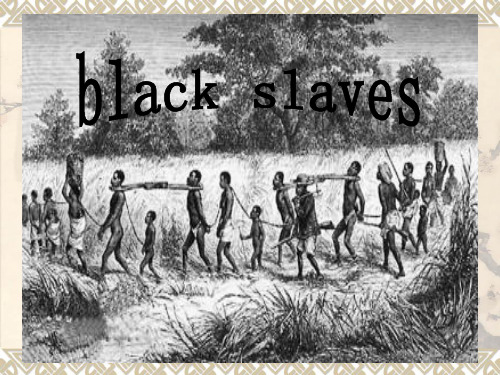
The Door Of No Return
Reproduction of a handbill advertising a slave auction in Charleston,So uth Carolina , in1769.
The Influence from Slavery
Labor shortage A large number died from overwork and diseases. Racism 非洲劳动力短缺 大量死于操劳过度和感染疾病 对黑人有严重的种族歧视
Atlantic slave trade
The Atlantic slave trade, also known as the transatlantic slave trade, refers to the trade in slaves that took place across the Atlantic ocean from the sixteenth through to the nineteenth centuries. The vast majority of slaves involved in the Atlantic trade were Africans from the central and western parts of the continent陆地, who were sold by African slave dealers商人 to European traders, who transported them to the colonies殖民地 in North and South America. There, the slaves were made to labor on coffee, cocoa and cotton plantations, in gold and silver mines, in rice fields, the construction industry, timber, and shipping or in houses to work as servants.
美国南北战争与奴隶制的废除

奴隶制的矛盾与南北战争的背景
美国南北战争与奴隶制的废除
奴隶制在美国社会中存在了近一个世纪,其矛盾在19世纪中叶日益尖锐。一方面,奴隶制被视为一种不公正的制度,它剥夺了黑人自由,且这种制度严重阻碍了国家的经济和人口发展。另一方面,南方地区的种植园经济对奴隶劳动力的需求量大,且认为奴隶制是一种自然的、符合上帝意愿的制度。此外,奴隶主们认为奴隶的价值远高于黑人自己认为自己的价值。这种矛盾不仅导致黑人奴隶的不满和反抗,也引发了白人之间的紧张关系。
从经济角度看,奴隶制的存在严重影响了美国的经济发展。在奴隶制下,奴隶劳动被视为生产成本的一部分,而不是生产力的来源。据统计,1860年,奴隶制经济占美国全国经济的40%,而同期英国工业革命的工业生产已经超过奴隶制经济。奴隶制经济对美国经济的发展造成了严重的阻碍。
其次,奴隶制对人类尊严的侵犯。奴隶制剥夺了人的自由、人的尊严和平等权利,造成了极大的伤害和痛苦。在南北战争之前,美国的黑人奴隶人口达到400万以上,这些人在生活中备受压迫和剥削,生命和健康得不到保障。
2. 北方经济的转型与南方不同,北方经济的发展以工业为主。
随着工业革命的发展,北方对自由劳动力的需求增加,而奴隶制度限制了北方对自由劳动力的获取。北方开始担心奴隶制度的存在会对美国的统一和稳定造成威胁。
3. 种族歧视的存在在南北战争前的美国,黑人奴隶制度被视为合法,而黑人则被视为劣等种族。这种种族歧视的存在导致黑人无法享有与白人平等的权利和机会,为后来的南北战争埋下了伏笔。
美国南北战争与奴隶制的废除过程
The American Civil War and the Abolition of Slavery
02
南北战争
奴隶制
中世纪
黑奴贸易【英文精品】

Slavery in the Colonies
New England colonies-no large plantation systems; slaves lived in cities and small farms Chesapeake Bay colonies-large tobacco plantations; center of the domestic slave trade Carolinas and Georgia-large rice and cotton plantations
Anthony Johnson
He was an African brought to the colonies in the 1620s. He obtained his freedom, and purchased 250 acres of land in Virginia. He owned at least one slave and white indentured servants. This shows that blacks were not thought of strictly as slaves until the 1660s.
Why Not Enslave the Native Population?
Native Americans were highly likely to catch European diseases. They were familiar with the terrain and could escape easier. They had political allies that could fight against the “owners.”
联合国秘书长废除奴隶制国际日致辞(双语)
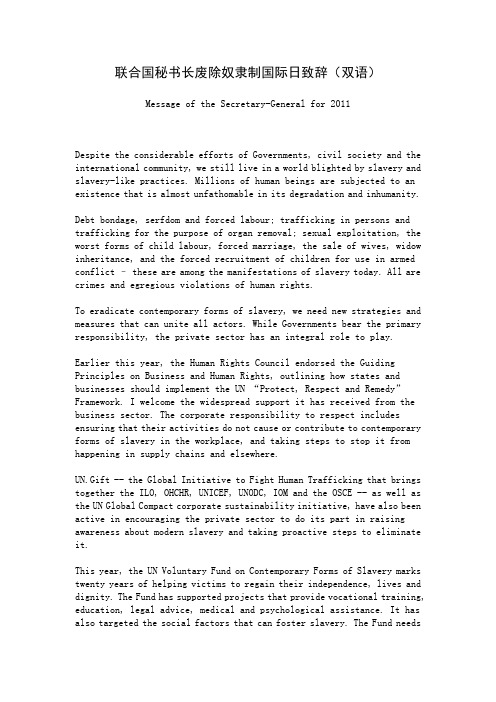
联合国秘书长废除奴隶制国际日致辞(双语)Message of the Secretary-General for 2011Despite the considerable efforts of Governments, civil society and the international community, we still live in a world blighted by slavery and slavery-like practices. Millions of human beings are subjected to an existence that is almost unfathomable in its degradation and inhumanity.Debt bondage, serfdom and forced labour; trafficking in persons and trafficking for the purpose of organ removal; sexual exploitation, the worst forms of child labour, forced marriage, the sale of wives, widow inheritance, and the forced recruitment of children for use in armed conflict –these are among the manifestations of slavery today. All are crimes and egregious violations of human rights.To eradicate contemporary forms of slavery, we need new strategies and measures that can unite all actors. While Governments bear the primary responsibility, the private sector has an integral role to play.Earlier this year, the Human Rights Council endorsed the Guiding Principles on Business and Human Rights, outlining how states and businesses should implement the UN “Protect, Respect and Remedy” Framework. I welcome the widespread support it has received from the business sector. The corporate responsibility to respect includes ensuring that their activities do not cause or contribute to contemporary forms of slavery in the workplace, and taking steps to stop it from happening in supply chains and elsewhere.UN.Gift -- the Global Initiative to Fight Human Trafficking that brings together the ILO, OHCHR, UNICEF, UNODC, IOM and the OSCE -- as well as the UN Global Compact corporate sustainability initiative, have also been active in encouraging the private sector to do its part in raising awareness about modern slavery and taking proactive steps to eliminate it.This year, the UN Voluntary Fund on Contemporary Forms of Slavery marks twenty years of helping victims to regain their independence, lives and dignity. The Fund has supported projects that provide vocational training, education, legal advice, medical and psychological assistance. It has also targeted the social factors that can foster slavery. The Fund needsa minimum of $1.5 million to fulfil its mandate, but less than a third of this amount has been secured to date.On this International Day, I appeal to all governments, business enterprises, NGOs and other partners to demonstrate their commitment to fighting slavery by making a financial contribution to the Fund, and by working closely together to end this scourge.各国政府、民间社会和国际社会尽管竭尽努力,我们生活的世界依然蒙在奴隶制和类似奴隶制的做法的阴影之中。
黑奴解放宣言 英文简介

“黑奴解放宣言”的英文简介The Emancipation ProclamationPresident Abraham Lincoln issued the Emancipation Proclamation on January 1, 1863, as the nation approached its third year of bloody civil war. The proclamation declared "that all persons held as slaves" within the rebellious states "are, and henceforward shall be free."Despite this expansive wording, the Emancipation Proclamation was limited in many ways. It applied only to states that had seceded from the Union, leaving slavery untouched in the loyal border states. It also expressly exempted parts of the Confederacy that had already come under Northern control. Most important, the freedom it promised depended upon Union military victory.Although the Emancipation Proclamation did not end slavery in the nation, it captured the hearts and imagination of millions of Americans and fundamentally transformed the character of the war. After January 1, 1863, every advance of federal troops expanded the domain of freedom. Moreover, the Proclamation announced the acceptance of black men into the Union Army and Navy, enabling the liberated to become liberators. By the end of the war, almost 200,000 black soldiers and sailors had fought for the Union and freedom.From the first days of the Civil War, slaves had acted to secure their own liberty. The Emancipation Proclamation confirmed their insistence that the war for the Union must become a war for freedom. It added moral force to the Union cause and strengthened the Union both militarily and politically. As a milestone along the road to slavery's final destruction, the Emancipation Proclamation has assumed a place among the great documents of human freedom.The original of the Emancipation Proclamation of January 1, 1863, is in the National Archives in Washington, DC. With the text covering five pages the document was originally tied with narrow red and blue ribbons, which were attached to the signature page by a wafered impression of the seal of the United States. Most of the ribbon remains; parts of the seal are still decipherable, but other parts have worn off.The document was bound with other proclamations in a large volume preserved for many years by the Department of State. When it was prepared for binding, it was reinforced with strips along the center folds and then mounted on a still larger sheet of heavy paper. Written in red ink on the upper right-hand corner of this large sheet is the number of the Proclamation, 95, given to it by the Department of State long after it was signed. With other records, the volume containing the Emancipation Proclamation was transferred in 1936 from the Department of State to the National Archives of the United States.。
slavery 翻译

slavery 翻译slavery (n.): 奴隶制度;奴隶状态例句:1. Slavery was a system prevalent in many ancient civilizations, where individuals were treated as property and forced to work without pay.(奴隶制度在许多古代文明中普遍存在,个人被视为财产并被迫无偿劳动。
)2. The abolitionist movement in the 19th century aimed to end slavery and grant equal rights to all individuals.(19世纪的废奴运动旨在终结奴隶制度并赋予所有个体平等权利。
)3. Slavery is considered a gross violation of human rights, as it deprives individuals of their freedom and dignity.(奴隶制度被视为对人权的严重侵犯,因为它剥夺了个体的自由和尊严。
)4. Many countries have laws prohibiting slavery and human trafficking in order to protect vulnerable individuals from exploitation.(许多国家制定了禁止奴隶制度和人口贩卖的法律,以保护弱势个体免受剥削。
)5. The transatlantic slave trade was a dark chapter in history, during which millions of Africans were forcibly transported and sold as slaves in the Americas.(大西洋奴隶贸易是历史上的黑暗篇章,期间数百万非洲人被强行运输并在美洲被贩卖为奴隶。
废除奴隶制英语作文
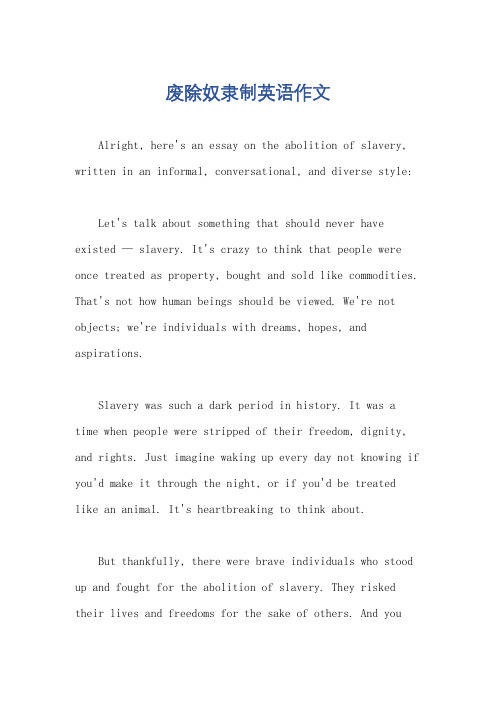
废除奴隶制英语作文Alright, here's an essay on the abolition of slavery, written in an informal, conversational, and diverse style:Let's talk about something that should never have existed — slavery. It's crazy to think that people were once treated as property, bought and sold like commodities. That's not how human beings should be viewed. We're not objects; we're individuals with dreams, hopes, and aspirations.Slavery was such a dark period in history. It was a time when people were stripped of their freedom, dignity, and rights. Just imagine waking up every day not knowing if you'd make it through the night, or if you'd be treatedlike an animal. It's heartbreaking to think about.But thankfully, there were brave individuals who stood up and fought for the abolition of slavery. They risked their lives and freedoms for the sake of others. And youknow what? They succeeded. They showed us that change is possible, and that we can make a difference.Today, we live in a world where slavery is illegal and frowned upon. But we still have a long way to go. There are still people out there who are treated like slaves, whether it's through forced labor or modern-day forms of slavery. So let's not forget the past and let's keep fighting for a world where everyone.。
林肯废除奴隶制英语作文

林肯废除奴隶制英语作文Abraham Lincoln's presidency was a turning point in American history, especially with his unwavering commitment to ending slavery. His Emancipation Proclamation in 1863 was a bold step towards freedom for millions.The Proclamation did not immediately free all slaves, but it set the stage for a new era. It changed the course of the Civil War, turning it into a battle for human rights as well as for preserving the Union.Lincoln's actions were not without controversy. Many opposed the idea of emancipation, fearing the social and economic upheaval it would bring. Yet, Lincoln's resolve remained steadfast, driven by his belief in the principles of equality and justice.The 13th Amendment, which Lincoln supported, ultimately abolished slavery throughout the United States. It was a testament to his leadership and the sacrifices made by those who fought for freedom.The legacy of Lincoln's Emancipation Proclamation continues to inspire. It stands as a reminder of the power of conviction and the importance of fighting for what is right, even in the face of adversity.In the years since, the struggle for civil rights hasevolved, but the spirit of Lincoln's Emancipation Proclamation endures. It is a beacon of hope that guides us towards a more just and equitable society.The journey towards true equality is ongoing, and Lincoln's Emancipation Proclamation serves as a powerful reminder that progress is possible. It is a call to action for all generations to continue the fight for freedom and justice.。
废除黑奴制度英文作文

废除黑奴制度英文作文The abolition of slavery was a pivotal moment in history. It marked the end of an era of oppression and exploitation, and paved the way for a more just and equitable society.The abolition of slavery was a hard-fought battle, led by courageous individuals who refused to accept the status quo. Their tireless efforts and unwavering determination ultimately led to the eradication of this abhorrent practice.The abolition of slavery was a long overdue victory for human rights. It was a triumph of the human spirit over greed and cruelty, and a testament to the power of collective action in the face of injustice.The abolition of slavery was a turning point in the struggle for equality. It served as a powerful reminder of the inherent dignity and worth of every individual,regardless of their race or background.The abolition of slavery was a cause for celebration, but it also served as a sobering reminder of the enduring legacy of racism and discrimination. It was a step forward, but it was not the end of the journey towards true equality and justice for all.。
废除黑奴制度英文作文
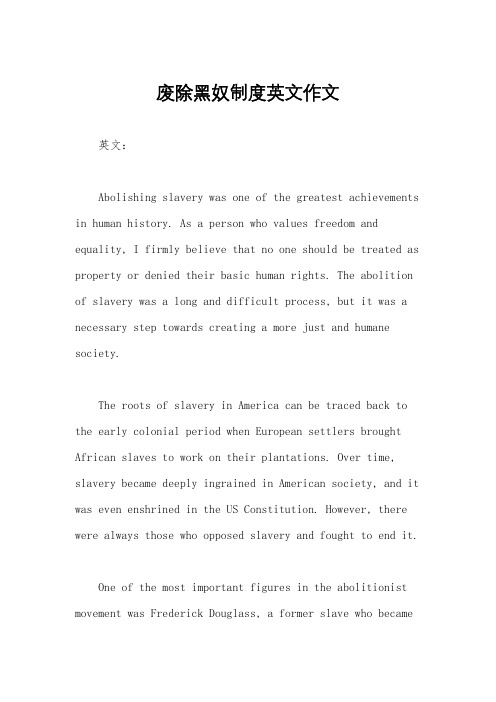
废除黑奴制度英文作文英文:Abolishing slavery was one of the greatest achievements in human history. As a person who values freedom and equality, I firmly believe that no one should be treated as property or denied their basic human rights. The abolition of slavery was a long and difficult process, but it was a necessary step towards creating a more just and humane society.The roots of slavery in America can be traced back to the early colonial period when European settlers brought African slaves to work on their plantations. Over time, slavery became deeply ingrained in American society, and it was even enshrined in the US Constitution. However, there were always those who opposed slavery and fought to end it.One of the most important figures in the abolitionist movement was Frederick Douglass, a former slave who becamea powerful advocate for freedom and equality. Douglass used his own experiences to educate others about the horrors of slavery and to inspire them to join the fight against it. His speeches and writings were instrumental in building public support for abolition.Another key figure in the abolitionist movement was Harriet Tubman, who escaped from slavery herself and then helped others to do the same through the Underground Railroad. Tubman risked her own life to lead slaves to freedom, and she became known as the "Moses" of her people.The abolition of slavery was not achieved overnight, but rather through a long and difficult struggle. The Civil War played a crucial role in ending slavery, as it was a war over the future of slavery in America. In 1863, President Lincoln issued the Emancipation Proclamation, which declared that all slaves in Confederate-heldterritory were free. This was a major turning point in the war and in the fight against slavery.Today, we can look back on the abolition of slavery asa great triumph of human rights. However, we must also recognize that the legacy of slavery continues to shape American society in many ways. Racism, inequality, and injustice are still major issues that we must confront and overcome. But by remembering the struggle to abolish slavery, we can draw inspiration and strength to continue the fight for a more just and equitable world.中文:废除奴隶制度是人类历史上最伟大的成就之一。
废除黑奴制度英文作文
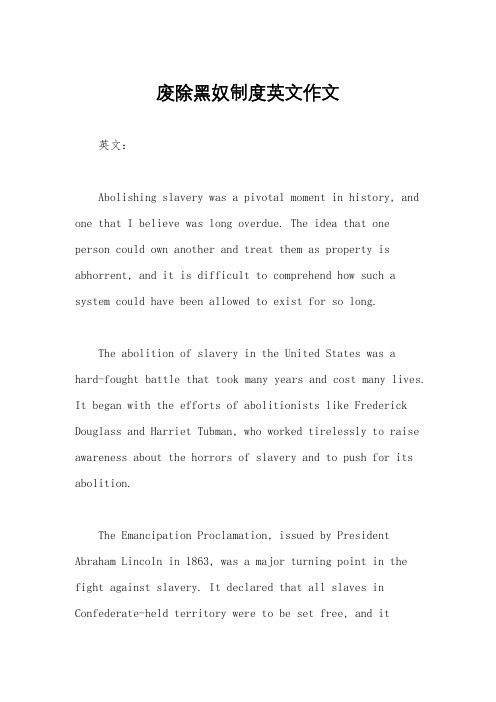
废除黑奴制度英文作文英文:Abolishing slavery was a pivotal moment in history, and one that I believe was long overdue. The idea that one person could own another and treat them as property is abhorrent, and it is difficult to comprehend how such a system could have been allowed to exist for so long.The abolition of slavery in the United States was ahard-fought battle that took many years and cost many lives. It began with the efforts of abolitionists like Frederick Douglass and Harriet Tubman, who worked tirelessly to raise awareness about the horrors of slavery and to push for its abolition.The Emancipation Proclamation, issued by President Abraham Lincoln in 1863, was a major turning point in the fight against slavery. It declared that all slaves in Confederate-held territory were to be set free, and itpaved the way for the eventual passage of the 13th Amendment to the Constitution, which abolished slavery throughout the United States.Of course, the abolition of slavery did not immediately solve all of the problems faced by African Americans. They continued to face discrimination and oppression for many years to come, and the struggle for civil rights continued well into the 20th century. But the abolition of slaverywas a crucial step in the right direction, and it paved the way for the progress that was to come.中文:废除奴隶制度是历史上的一个重要时刻,我认为这是早就应该实现的。
奴隶的英语单词

奴隶的英语单词
奴隶的英语单词
以前的奴隶制度大家都已经不陌生了,现在这个时代已经没有这种制度了,但是我们仍然可以在英语中看到关于奴隶的单词。
1. Slave
这个单词是指奴隶,是最常见的关于奴隶的英语单词。
在奴隶制度时期,黑人和其他受压迫的人种就是被视为奴隶。
2. Slavery
这个单词是指奴隶制度,是 slave 的名词形式。
在过去的奴隶制度时期里,奴隶就是无权无势的存在,被奴役,被压迫,被迫害,根本不能自由地做出自己的选择。
3. Abolitionist
在奴隶制度时期,有一些人反对奴隶制度,他们被称为Abolitionist,可以简单理解为废奴主义者。
4. Emancipation
Emancipation 是指解放,是指奴隶制度结束、奴隶得到自由,变成自由人的过程。
5. Underground Railroad
Underground Railroad 也是一个关于奴隶的名词,字面意思是地下铁路,它是指在奴隶制度时期里,向北逃亡的奴隶所走的路线,这是一条秘密通道,专门为逃亡奴隶开辟的,里面包括了许多险恶的营地和救援站。
总之,历史上曾经存在的奴隶制度是人类的耻辱,但是它也构成了人类历史的一部分,奴隶制度的剥夺性、侮辱性和残酷性,不仅仅给奴隶自身带来了不幸,也给人类文明带来了极大的污染和伤害。
通过学习有关奴隶的英语单词,我们可以让我们更加重视我们现有的文明和制度,珍惜我们的独立和自由。
abolish

2双语例句
3词典释义
基本信息
v.(动词)
废止
废除
彻底破坏
消灭
撤销
取消
革除
(尤指)使(法律)无效
完全破坏
双语例句
用作动词(v.)
用作及物动词S+~+ n./pron.
The Americansabolishedslavery in 1863.美国于1863年废除奴隶制度。
The Emancipation Proclamationabolishedslavery in the United States.《解放宣言》废除了美国的奴隶制度。
The governmentabolishedthe tax on food.政府取消了食品税。
Theyabolisheda department last year.他们去年撤销了一个部门。
No plan will be accepted unless itabolishespoverty.任何计划都是不可接受的,除非它消除贫困。
The countryabolishedits monarchy and became a republic.这个国家废除君主制成为共和国。
Doabolishthis kind of bad custom.一定要废除这种不好的习俗。
Should weabolishthe death penalty?我们应当废止死刑吗?
abolish
Abolish是一个英语单词,一般用作及物动词,可翻译为废除、取消、变革。
基本信息
外文名称
abolish
及物Байду номын сангаас词
.废除;取消;变革
第三人称单数
abolition用法和搭配

任务名称:abolition用法和搭配一、什么是abolition?Abolition这个词源于拉丁语的abolitio(意为“废除”),是一个名词,指的是废除或取消某种制度、规定或法律。
它常常用来描述对某种不合理、不公正或不道德的制度的彻底废除。
二、abolition的常见用法1. 废除奴隶制度最著名且广泛使用abolition一词的场景就是指废除奴隶制度。
在历史上,许多国家和地区通过法律手段废除了奴隶制度,这被称为奴隶制度的废除运动(abolition movement)。
例如,美国历史上发生了一场著名的奴隶制度废除运动,即美国奴隶制度废除运动(American abolition movement)。
这场运动旨在通过政治和社会行动来消除美国南方各州存在的奴隶制度,并最终导致了美国内战(American Civil War)。
2. 废除死刑另一个常见的使用场景是指废除死刑。
一些国家和地区认为死刑违背人权和尊严,并通过立法或宪法来废除死刑。
这被称为废除死刑运动(abolition of the death penalty movement)。
例如,欧洲理事会是一个致力于推动废除死刑的国际组织。
该组织的成员国都已经废除了死刑,并积极参与全球范围内的废除死刑运动。
3. 废除贸易壁垒另外一个使用abolition一词的领域是指废除贸易壁垒。
贸易壁垒包括关税、配额和非关税壁垒等,这些措施限制了国际贸易的自由和公平。
废除贸易壁垒旨在促进自由贸易和全球经济一体化。
世界贸易组织(World Trade Organization)是一个国际组织,致力于推动全球范围内的自由贸易,并通过谈判和协商来逐步消除各国之间的贸易壁垒。
三、abolition常见搭配1. abolitionistAbolitionist是abolition的派生词,指的是主张或参与废除某种制度或规定的人。
在历史上,奴隶制度废除运动中的积极分子被称为abolitionist。
欧洲近代历史大全之废除奴隶制中英双语

The Decree Abolishing the Feudal System, August 11, 1789废除封建制法令1789年八月十一日J.H. Robinson, ed., Readings in European History 2 vols. (Boston: Ginn, 1906)J.H.罗宾森欧洲历史第二卷(波士顿:吉恩,1960年)二组:Robinson's Note: The abolition of the feudal system, which took place during the famous night session of August 4-5, 1789, was caused by the reading of a report on the misery and disorder which prevailed in the provinces. 罗宾森笔记:封建制度的废除发生于1789年八月四日到五日那个著名夜晚会议,是由于阅读了对席卷地方的悲惨境况和暴动骚乱的报道所导致的。
The report declares that " Letters from all the provinces indicate that property of all kinds is a prey to the most criminal violence;报道宣称:来自各个地方的信件都表明,各种各样的财产,都是暴力犯罪的牺牲品;on all sides chateaux are being burned, convents destroyed, and farms abandoned to pillage. 在各处,城堡被焚毁,女修道院被破坏,农场陷入劫掠。
The taxes, the feudal dues, all are extinct; 税金、封建税费,都已灭绝;the laws are without force, and the magistrates without authority.法律没有强制力,地方行政官也没有权利。
奴隶制用英语怎么说

奴隶制用英语怎么说奴隶制,是指奴隶主拥有奴隶的制度。
劳力活动须以奴隶为主,无报酬,且无人身自由。
那么,你知道奴隶制的英语怎么说吗?奴隶制的英文释义:slaveryhelotism奴隶制的英文例句:我的最高目标是拯救美国,摧毁奴隶制度。
My paramount object is to save the union and destroy slavery.反对奴隶制的人则不想让(奴隶制)蔓延开去。
People who opposed slavery did not want it to spread.就是林肯把黑人从奴隶制下解放出来的。
It was abraham lincoln who freed the black from the slavery.古埃及金字塔是奴隶制帝王的陵墓。
Pyramids functioned as tombs for pharaohs.所有人道主义者都反对奴隶制。
All humanitarians are against slavery.奴隶制为古代社会提供了基Slavery provided the foundation for many ancient types of society.应该彻底废除奴隶制。
The slavery should be abolished completely.这项法令废除了奴隶制。
The law does away with slavery.奴隶制在世界一些地方仍然存在着。
Slavery still exists in some parts of the world.他领导我们废除了奴隶制。
He headed us abolishing the slavery.在南北战争结束之后,美国的奴隶制被废除了。
The slavery was overthrown after the Civil War in U.S.A.我是否感到这个国家的奴隶制和种族歧视史与我有关?Do I identify with the legacy of slavery and discrimination in this country?嗯,他是怎样为奴隶制辩护的?Well, what is his defense of slavery?他说,在我们这个国家的一部门地区认为奴隶制是正确的,而且应该扩张。
- 1、下载文档前请自行甄别文档内容的完整性,平台不提供额外的编辑、内容补充、找答案等附加服务。
- 2、"仅部分预览"的文档,不可在线预览部分如存在完整性等问题,可反馈申请退款(可完整预览的文档不适用该条件!)。
- 3、如文档侵犯您的权益,请联系客服反馈,我们会尽快为您处理(人工客服工作时间:9:00-18:30)。
Anti-slavery medallion created by Josiah Wedgewood in 1787.
Incidentally, Josiah Wedgewood was Charles Darwin’s maternal grandfather.
- Kwa chant about the disappearance of an African boy, Equiano
Equiano’s Interesting Narrative
Equiano describes his terror as a young boy taken aboard a slave ship. He believes white men are demons who plan to eat him. His account balances a sense that Europeans had such advanced technology that they seemed like magicians with a sense that they are less civilized than Africans – more cruel, less concerned with cleanliness and much less modest concerning women.
Mary Prince
Mary Prince, a West Indian slave, published her narrative in 1831, a few years before the abolition of slavery. Her story forms a catalogue of horrors. Prince describes the separation of slave families and the brutal treatment of fellow slaves, like her friend Hetty, whose beating resulted in a miscarriage, as well as her own sufferings at the hands of cruel masters – she is beaten for breaking a jug and for letting a cow loose -- and in the terrible labor in the salt ponds.
Olaudah Equiano
ቤተ መጻሕፍቲ ባይዱ
Equiano published his book The Interesting narrative of the Life of Olaudah Equiano, or Gustavus Vassa, the African in 1789. It went through 25 printings before his Death in 1797.
By 1699 one out of every four ships that left Liverpool harbor was a slave ship.
Diagram of the “triangle trade”
The Triangle Trade
The British dominated the slave trade during the 18th century until its end in the 19th. British traders brought manufactured goods to Africa (first passage). They sold those goods for slaves and brought them to the Caribbean and mainland American colonies (middle passage) With their profits, the traders bought raw materials like sugar, tobacco, molasses and spices, to sell in England (third passage).
Who are we looking for, who are we looking for? It's Equiano we're looking for. Has he gone to the stream? Let him come back. Has he gone to the farm? Let him return. It's Equiano we're looking for.
The Origins of the TransAtlantic Slave Trade
Europeans begin importing slaves from Africa by the end of the 14th century. Sir john Hawkins became the first English slave trader in 1562. By 1650, newly established sugar and tobacco plantations in the Caribbean British colonies and on the American mainland made slavery extremely profitable.
Equiano’s Story
One powerful aspect of Equiano’s account involves his struggle for freedom. One master, Michael Pascal, promises to free him, only to sell him at the end of a voyage. Another, Robert King, offers to free him for a fee of forty pounds, but is shocked when Equiano actually earns that much. He has to be persuaded by another man to honor his agreement. After he wins his freedom, Equiano is often cheated by whites and is under constant threat of being reenslaved.
